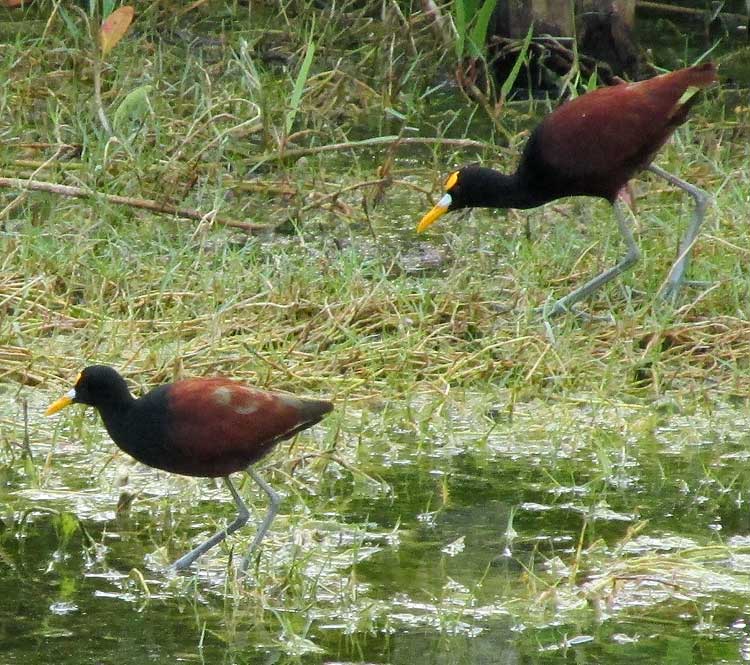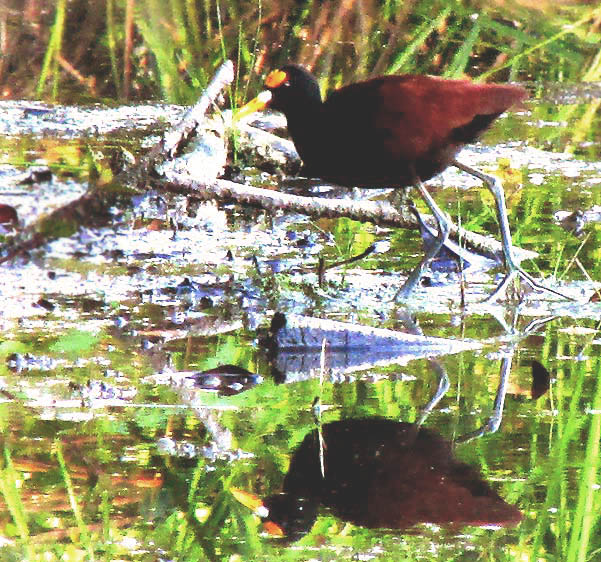Excerpts from Jim Conrad's
Naturalist Newsletter

from the April 5, 2015 Newsletter issued from Río Lagartos, on the Yucatan Peninsula's northern coast (~N21.60°, ~W88.16°), Yucatán state, MÉXICO
NORTHERN JACANAS
Wherever the coastal road passes through marshes or has ponds along its banks, you're likely to see Northern Jacanas, JACANA SPINOSA. Above, a couple is shown in a typical wet-grassy habitat. In that picture the nearest bird is considerably smaller than the one in the back. Among jacanas, females grow to be about twice as large as males.
Jacanas inhabit swamps, marshes, and ponds of coastal areas from Mexico and the Caribbean south to Panama, and in these habitats they are exquisitely adapted for one particular niche: that of floating vegetation, and partially submerged vegetation such as is shown in our photo. The most obvious of their adaptations for this niche consists of their feet, which bear outlandishly long toes and claws. By distributing the bird's weight over a large surface area, the toes enable jacanas to walk atop waterlily pads and other floating vegetation, or at least to cause the floating herbage to sink more slowly as the bird passes over it. During its foraging walks the jacana feeds mostly on snails, worms, small crabs, fish, mollusks, and seeds.
The matter of the females being twice as large as the males has much to do with how the birds organize their sex lives. For, in this species the females are "polyandrous" -- meaning that during a single nesting season the female mates with one to four male birds, lays her eggs in all the nests of her males, and defends her territory from other females. The males build the nests, incubate the eggs, raise the young, teach the young how to forage, and during emergencies scoop up the young and carries them to safety under their wings.
Jacanas belong to the same Shorebird Order as gulls, sandpipers and skimmers, the Charadriiformes. At first glance this is a little surprising because they look more like coots, gallinules and rails of the Crane Order, the Gruiformes. Jacanas occupy nearly the same habitat as Soras ,of the Crane Order, and share the long-legged-chicken appearance, so one thinks of convergent evolution -- the evolution of not-closely-related species toward the same general appearance, because that appearance or form enables the organism to most efficiently exploit resources in that particular habitat.
Jacanas are easy to see and watch, and when you know the particulars of their living arrangement, fascinating and thought provoking.
note from October 1, 2019, taken during a camping trip to Rosario National Park on the west side of Sayaxché, Petén, northern GUATEMALA
TOES
It's been hard to get a good picture of the jacana's enormous toes. The picture below shows most of two toes on the leg partly withdrawn, which starts to give an idea of the toes' length, but I'm still trying for a whole foot
